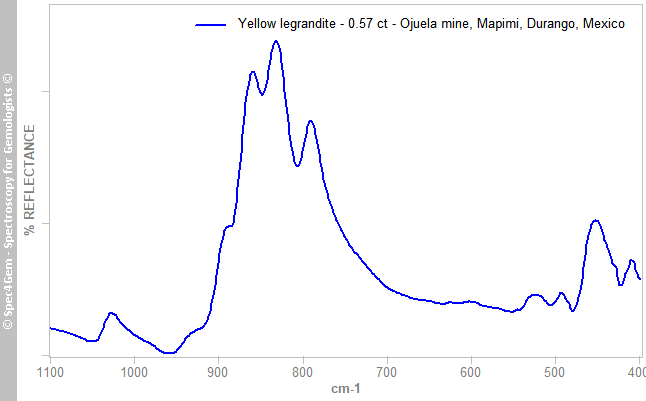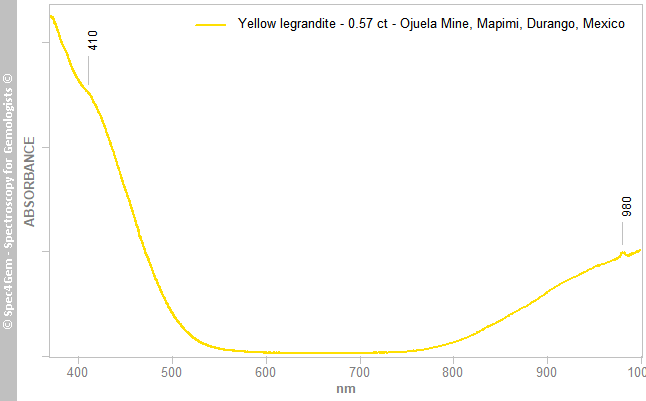Yellow legrandite from Ojuela mine, Mapimi district, Durango, Mexico
- Details
- Created: Tuesday, 26 June 2018 22:10
Legranddite named after M. Legrand, a Belgian mining engineer, was first described in 1934 for an occurrence in the Flor de Pena mine, Nuevo Leon, Mexico. It is a rare zinc arsenate mineral, Zn2(AsO4)(OH)·(H2O) occuring as an uncommon secondary mineral in the oxidized zone of arsenic bearing zinc deposits. Associated minerals include: adamite, scorodite, smithsonite, aurichalcite, siderite, goethite, pyrite and many more. Apart its type locality it has been reported from Tsumeb, Namibia; the Ojuela mine in Durango, Mexico and at Sterling Hill, New Jersey, US.
Legrandite is very rarely faceted because of the scarcity and the brittleness of the material. The legrandite (figure 1) of this study is from Ojuela mine in Mapimi district, Durango, Mexico. It is from the parcel recently described in the Journal of Gemmology[3].
 Figure 1. This 0.57 ct yellow legrandite from Ojuela mine includes
Figure 1. This 0.57 ct yellow legrandite from Ojuela mine includessome veils.
| Shape | oval |
| Size |
5.6 x 4.2 x 2.8 mm |
| Color | yellow |
| Lustre | vitreous |
| Weight | 0.57 ct |
| SG | 4.07 [3.97 - 4.05, 4.08 - 4.12[3]] |
| RI | 1.700 - 1.738 [1.675 - 1.742, 1.699 - 1.739[3]] |
| DR | 0.038 B+ [0.050 - 0.070 B+, 0.037 - 0.040 B+[3]] |
| Pleochroism | none |
| Polariscope / Conoscope | anisotropic: light/dark 4 times / 360°, conoscope not used |
| SWUV | inert |
| LWUV | inert |
| Magnetic susceptibility N52 | very weak |
| Chelsea filter | yellow as without the filter |
Table 1. Observational and measured properties
Infrared reflectance spectroscopy:
The IR reflectance spectrum (figure 2) collected from the stone's table shows a pattern consistent with arsenates which are characterized by the main reflectance bands located in the 700-900 cm-1 range. This spectrum can be compared to other spectra of the legrandite from the same locality acquired using different IR spectroscopic methods such as ATR (RRUFF database - Legrandite R040151)[1] and transmittance (Nikita V. Chukanov - p1597)[2].
 Figure 2. The IR reflectance spectrum of this 0.57 ct yellow legrandite from Ojuela mine in Mexico shows an arsenate spectrum pattern characterized by the bands in the 700-900 cm-1.
Figure 2. The IR reflectance spectrum of this 0.57 ct yellow legrandite from Ojuela mine in Mexico shows an arsenate spectrum pattern characterized by the bands in the 700-900 cm-1.UV-VIS-NIR spectroscopy:
The UV-Vis spectrum (figure 3) was collected with the light path crossing the stone perpendicularly to the table and entering the stone at the culet point. The spectrum shows a large transmission window between 520 and 800 nm resulting in the yellow color shown by the stone. This transmission window is delimited by a strong absorption starting at 500 nm and increasing rapidly towards the UV with a shoulder around 410 nm and a large absorption band towards IR starting around 800 nm. A narrow band at 980 nm, characteristic of the water in the crystal lattice is consitent with the legrandite chemical formula: Zn2(AsO4)(OH)·H2O.
The absorptions in the UV, violet, blue and green and in the near-infrared could possibly attributed to iron which often shows similar absorptions in many minerals.
 Figure 3. The UV-Vis-NIR spectrum of this 0.57 ct yellow legrandite from Ojuela mine in Mexico shows a large transmission window between 520 and 800 nm causing the yellow color. The strong absorption towards the UV shows a shoulder around 410 nm. A 980 nm narrow band characterizes the presence of water.
Figure 3. The UV-Vis-NIR spectrum of this 0.57 ct yellow legrandite from Ojuela mine in Mexico shows a large transmission window between 520 and 800 nm causing the yellow color. The strong absorption towards the UV shows a shoulder around 410 nm. A 980 nm narrow band characterizes the presence of water.Photoluminescence spectroscopy:
No photoluminescence with the following sources: 254, 280, 375, 405 and 532 nm.
Conclusion:
Legrandite is an unusual gemstone rarely available and faceted, its low hardness of 4½ on Mohs scale makes it a collector's gemstone. The IR reflectance spectroscopy confirmed the nature of the material being an arsenate. The UV-Vis-NIR spectroscopy revealed the presence of water, and tends to indicate the yellow color might be caused by iron, this later hypothesis has to be confirmed.
[1] RRUFF database - Legrandite R040151
[2] Infrared spectra of mineral species, Nikita V. Chukanov, 2014, Springer, ISBN: 978-94-007-7128-4, p. 1597.
[3] Legrandite from Mapimi, Mexico, D. Gravier, B. M. Laurs, Journal of Gemmology, 2018, volume 36, No.2, p. 100.

